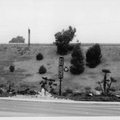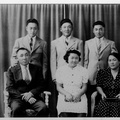Read part 1 >>
It was August 1942 when we boarded trains to unknown places. I remember going through Los Angeles with the shades drawn; the trip ended a few days later in the hot deserts of Arizona. They transported us by bus from Phoenix to Gila (Canal) Relocation Camp. The temperature outdid Fresno’s heat! How the city people could cope with this was unbelievable! One former schoolmate from Kingsburg died from valley fever. The internment should never have happened!
Life in Canal Camp was bearable for the Shinmoto family, but it was time to make a move after two years behind barbed-wire fences. Tony and Herky found sugar beet farm work in Malta, Montana. Next, Min and Tony got houseboy and ice storage work in icy Colorado Springs, Colorado. Finally, the whole family settled on a dairy farm in Elkhorn, Nebraska. We rented an abandoned farmhouse that had two rooms with no electricity, heating or running water. We had to clean out the water storage tank before we could use it; the tank stood on top of a hill and had dead snakes, rodents and birds in it. After a while, Tony could not stand it any longer. The dairy owner broke promises about work availability and provided poor living conditions. Tony got in an argument with the dairy owner that turned into a “wrestling match” with Tony ending on top!
Min moved on east to Burlington, Iowa to do general house cleaning for room and board at the Burlington Hotel. Min negotiated with the General Manager, Mr. Ross Burman, to provide work for the family; Tony sent word that the family would arrive as soon as possible. The owners, Mr. Pettigrew and Mr. Burman, had two hotels with plenty of work for the whole family. Our family lived in a large farmhouse where we could raise chickens and farm vegetables. The townspeople complained about the hotel using “Japs,” but Mr. Burman put their minds at ease, saying that two of the Shinmoto sons were serving in the United States Army. Herky was drafted while working for Pillsbury in Omaha, Nebraska and Min was
Herky was drafted while working for Pillsbury in Omaha, Nebraska and Min was inducted in St. Louis, Missouri. Both took basic training at Fort McClellan in Alabama and Japanese Military Language School at Fort Snelling in Minnesota. The earlier studies in Seinan at the Senshin Japanese School eased the difficult training program. Shortly after graduation and the bombing of Hiroshima and Nagasaki, the war ended.
With Japan’s surrender, Herky’s and Min’s first assignments were overseas to an unknown destination, both landing separately in Manila, Philippines. Unfortunately, lying in the bunk seasick under the ship’s covered deck remains the only memorable recollection of that two week trip aboard the luxury ship, S.S. Lurline. Luckily, there was no roll call or K.P. duty. Learning from our last experience at sea, we laid down on the open deck with a intense rainfall for six days straight aboard the liberty ship, USS. Kinkaid. According to the seasoned sailors aboard the Kinkaid, the typhoon that hit us was the worst they had ever experienced. It was later explained that there had been a scare of the ship possibly splitting into two!
We finally weathered the storm and arrived in Yokohama. We admired the coastal landscape while we entered the harbor. Our first impression of Japan was that it was truly beautiful. The momentary beauty that greeted us quickly changed as we arrived at the Tokyo Railroad Station aboard trains. The Army housed us in the NYK Building near the Imperial Palace. The aerial bombing damage in this area was minimal. Nevertheless, people sleeping in the train station and on the streets remained a grim testimony to the aftermath of war.
The first glimpse of devastated Hiroshima was in November 1945, en route to our first assignment in Fukuoka City, Kyushu, Japan’s southernmost island. Only the steel skeletons of office buildings remained standing. Streetcars ran on empty roads. Later, while seeking the Tanaka family (i.e., my mother’s family), we learned that mother’s older sister had passed away in the aftermath of the atomic bombing. Surviving members included five uncles, one aunt, lots of cousins and grandfather Tanaka, ironically with his chain-smoking habit.
The Shinmoto relatives lived on the island of Etajima, a short ferryboat ride from Hiroshima. After meeting more cousins and an uncle, we were to learn that father had seven sisters and two brothers. Two of the sisters were twins, which would later explain the set of twins in the Shinmoto family, two generations later.
* This article presents an excerpt from the book Seinan: Southwest Los Angeles, Stories and Experiences from Residents of Japanese Ancestry (2011) published by JA Living Legacy.
* * *
SEINAN PANEL
Sunday, October 30, 2011 • 2pm
Japanese American National Museum
Come hear how Southwest Los Angeles was a thriving Nisei community that was almost wiped out with the forced removal and events of World War II.
Presented in collaboration with JA Living Legacy and the Japanese American National Museum.
© 2011 Japanese American Living Legacy





